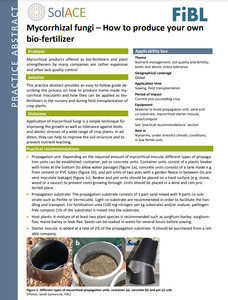{Tool} Mycorrhizal fungi – How to produce your own bio-fertilizer (SolACE Practice abstract). Creator(s): Symanczik, Sarah. Issuing Organisation(s): FiBL - Research Institute of Organic Agriculture. SolACE Practice abstract. (2019)
|
PDF
- English
(Mycorrhizal fungi – How to produce your own bio-fertilizer)
576kB | |
|
PDF
- German/Deutsch
454kB | |
|
PDF
- Hungarian/Magyar
468kB | |
![[thumbnail of 2023-01-09 12_41_19-Mycorrhizal fungi – How to produce your own.png]](/41888/7.hassmallThumbnailVersion/2023-01-09%2012_41_19-Mycorrhizal%20fungi%20%E2%80%93%20How%20to%20produce%20your%20own.png)  Preview |
Image (PNG)
- Cover Image
- English
208kB |
Document available online at: https://zenodo.org/record/3385633#.YSdjOY4zaUk
Summary in the original language of the document
Outcome
Application of mycorrhizal fungi is a simple technique for improving the growth as well as tolerance against biotic and abiotic stresses of a wide range of crop plants. In addition, they can help to improve the soil structure and to prevent nutrient leaching.
Practical recommendations
- Propagation unit: Depending on the required amount of mycorrhizal inocula, different types of propagation units can be established: container, pot or concrete units. Container units consist of a plastic beaker with holes at the bottom (to allow water passage) (figure 1a), concrete units consists of a tank made e.g. from cement or PVC tubes (figure 1b), and pot units of two pots with a garden fleece in between (to prevent inoculate leakage) (figure 1c). Beaker and pot units should be placed on a hard surface (e.g. stone, wood or a saucer) to prevent roots growing through. Units should be placed in a wind and rain protected place.
- Propagation substrate: The propagation substrate consists of 1 part sand mixed with 9 parts co-substrate such as Perlite or Vermiculite. Light co-substrate are recommended in order to facilitate the handling and transport. For fertilization urea (100 mg nitrogen per kg substrate) and/or mature, pathogenfree compost (1% of the substrate) is mixed into the substrate.
- Host plants: A mixture of at least two plant species is recommended such as sorghum-barley, sorghumflax, maize-barley or leek-flax. Seeds can be soaked in water for several hours before sowing.
- Starter inocula: Is added at a rate of 2% of the propagation substrate. It should be purchased from a reliable company.
- Set-up and harvest: Units are filled with pre-mixed substrate and irrigated (figure 2a). Starter inocula is added as a layer 5-8 cm below the substrate surface (figure 2b) and covered with another layer of substrate (figure 2c). Host plant seeds (amount dependent on host plant species) are distributed onto the surface (figure 2d), covered with a layer of substrate (figure 2e) and irrigated. Ninety days after sowing, irrigation is stopped to dry the substrate completely. Shoots are removed and roots are cut inside the propagation unit into small pieces of 1- 1.5 cm using scissors and mixed with the substrate. Then the mycorrhizal inoculate is ready. For quality check, root samples can be taken before drying the substrate to measure mycorrhizal colonization (%RLC) and subsamples of the dried inoculants to assess spore abundance and purity (see practice abstract “Mycorrhizal assessments”).
- Application: Mycorrhizal inocula can be used for applications at the nursery stage by adding 100 ml inocula to the root system and during field transplantation by spreading 200 ml inocula into the planting hole below the root system.
| EPrint Type: | Practice tool |
|---|---|
| What problem does the tool address?: | Mycorrhizal products offered as bio-fertilizers and plant strengtheners by many companies are rather expensive and often lack quality control. |
| What solution does the tool offer?: | This practice abstract provides an easy-to-follow guide describing the process on how to produce home-made mycorrhizal inoculants and how they can be applied as biofertilizers in the nursery and during field transplantation of crop plants. |
| Country: | Switzerland |
| Type of Practice Tool: | Practice abstracts |
| Keywords: | nutrient management, soil quality, soil fertility, mycorrhizae, Abacus, FiBL10103 |
| Agrovoc keywords: | Language Value URI English nutrient management http://aims.fao.org/aos/agrovoc/c_330697 English soil quality http://aims.fao.org/aos/agrovoc/c_a9645d28 English soil fertility http://aims.fao.org/aos/agrovoc/c_7170 English mycorrhizae http://aims.fao.org/aos/agrovoc/c_5023 |
| Subjects: | Soil > Soil quality Crop husbandry > Composting and manuring |
| Research affiliation: | Switzerland > FiBL - Research Institute of Organic Agriculture Switzerland > Crops > Composting and fertilizer application > Fertilizer application Switzerland > FiBL - Research Institute of Organic Agriculture Switzerland > Crops > Composting and fertilizer application > Plant nutrition European Union > Horizon 2020 > SolACE European Union > Organic Farm Knowledge |
| Horizon Europe or H2020 Grant Agreement Number: | 727247 |
| Related Links: | https://www.solace-eu.net/, https://organic-farmknowledge.org/de/tool/41888, https://zenodo.org/record/3385633#.YSdjOY4zaUk, https://www.facebook.com/organicfarmknowledge/posts/327420529170588, https://twitter.com/farm_knowledge/status/1432236925302231041 |
| Project ID: | ofk |
| Deposited By: | Forschungsinstitut für biologischen Landbau, FiBL |
| ID Code: | 41888 |
| Deposited On: | 26 Aug 2021 09:57 |
| Last Modified: | 02 May 2024 10:32 |
| Document Language: | English |
| Status: | Published |
Repository Staff Only: item control page

 Download Statistics
Download Statistics Download Statistics
Download Statistics
